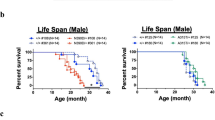Abstract
About 15–20% of patients with familial amyotrophic lateral sclerosis (ALS) carry one of several missense mutations in the gene for Cu,Zn superoxide dismutase (SOD1). We have previously reported on an animal model of this disease produced by the transgenic expression of a mutant form of human SOD1 containing a Gly93→Ala amino acid substitution. Several lines of transgenic mice were produced, characterized by a differing tempo and severity of disease that generally correlated with the number of mutant gene copies that these lines expressed. We reported that mice expressing high copy numbers (18–25) developed a disease with a relatively short course and with a pathology mainly characterized by severe vacuolar degeneration of motor neurons and their processes. Lewy-like bodies and swollen axons were also present. The exquisite localization to motor neurons was the feature that made the pathology in these overexpressors germane to the human disease. Severe vacuolar degeneration, however, was considered to be at variance with human ALS, in which similar changes have not been described. In the present study, we have made a temporal characterization of microscopic and immunohistochemical changes in a line of transgenic mice expressing lower copy numbers of the mutant gene. These mice, designated G5/G5, survive more than 400 days and present pathological changes which are virtually identical to those in the human disease. In fact, in these animals, anterior horn cell depletion, atrophy, astrocytosis, and the presence of numerous ubiquitinated Lewy-like bodies and axonal swellings are the main pathological features, while vacuolar pathology is minimal. This study underscores the importance of the level of expression of the mutant enzyme in the resulting clinical and pathological disease, and supports the value of this transgenic model as an excellent tool for investigating both pathogenesis of human ALS and possible therapeutic avenues.
Similar content being viewed by others
Author information
Authors and Affiliations
Additional information
Received: 11 September 1996 / Revised, accepted: 18 October 1996
Rights and permissions
About this article
Cite this article
Canto, M., Gurney, M. A low expressor line of transgenic mice carrying a mutant human Cu,Zn superoxide dismutase (SOD1) gene develops pathological changes that most closely resemble those in human amyotrophic lateral sclerosis. Acta Neuropathol 93, 537–550 (1997). https://doi.org/10.1007/s004010050650
Issue Date:
DOI: https://doi.org/10.1007/s004010050650




